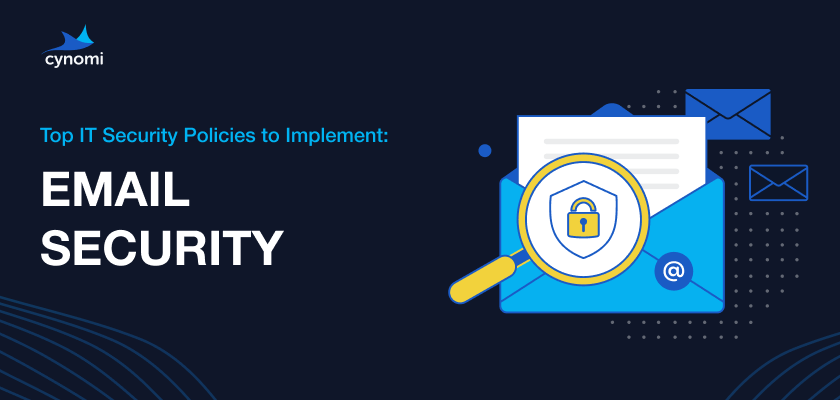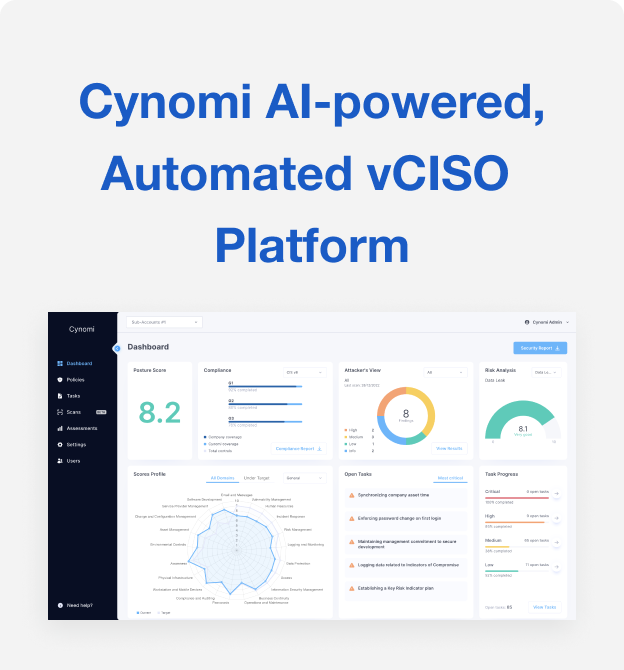Top IT Security Policies to Implement: Email Security

Email is a critical communication tool for businesses of all sizes, but it is also a common entry point for cyberattacks. From phishing scams to malware, cyber criminals use email as a way to gain access to sensitive information, steal credentials, and compromise systems. In fact, 78% of organizations experienced email-based ransomware attacks in 2021 according to Proofpoint’s “2022 State of the Phish” report, and 75% of cyberattacks started with an email as stated in a TrendMicro report. Therefore, implementing an email security policy is essential to protect your business from cyber threats.
In this blog post, we will discuss the importance of an email security policy and its top controls.
Why Is This Policy Important?
From a cybercriminal’s point of view, email is one of the basic attack surfaces and an easy way to penetrate an organization. All organizations use email as a tool for external communication, employees often don’t detect suspicious emails, and automation helps bad actors create customized email attacks effortlessly. Recent development in ChatGPT and other AI engines add ‘fuel to’ the phishing email fire making it even easier to generate email scams.
Email security is a fundamental policy to implement in any organization as it helps to protect against these threats. A comprehensive email security policy outlines the rules and procedures for using email within the organization. It ensures that employees are aware of their responsibilities and provides guidelines for protecting sensitive data and preventing cyberattacks. In many industries, an email security policy is required in order to comply with regulations and standards.
The Attacks This Policy Help Protect Against
A comprehensive email security policy helps protect from various attacks that start with an email message. This includes malware and ransomware that is delivered through email, phishing emails including spear phishing, and Business Email Compromise (BEC) which uses social engineering tactics. These types of attacks often lead to data breaches, loss of data and/or money, and exposure of sensitive data.
The Scope of This Policy
The email policy applies to anyone with access to a company email account, including management, IT staff, third-party employees, temporary employees, agents, vendors, and advisors.
Top Controls in This Policy
The controls listed below are the foundational components of a strong email security policy. By following them, you can improve your email security:
- Employee education and training: To reinforce employees’ proper email account usage, perform regular email security training and awareness exercises including phishing attack simulations. All email account holders must participate in these training sessions.
Why?
Employees are often the weakest link in an organization’s email security. Providing regular education and training on how to identify and report suspicious emails, how to use email securely, and the risks of phishing attacks can help prevent data breaches. - Email filtering and blocking: Implement an email filtering solution to prevent unwanted and malicious emails from reaching employees’ inboxes. This can include filtering for spam, malware, and phishing emails, as well as blocking emails from known malicious domains or IP addresses.
Why?
By using an email filtering and blocking solution, organizations can reduce the risk of employees accidentally clicking on malicious links or downloading infected attachments, which can have serious consequences for the organization. - Password policies: Enforce strong and unique passwords for email accounts, and prohibit password sharing.
Why?
Strong password policies help prevent unauthorized access to email accounts. Email accounts often contain sensitive and confidential information and can be exploited by cybercriminals to move laterally in the organization. By enforcing strong and unique passwords, organizations can significantly reduce the risk of email account breaches. - Encryption: Use email encryption to protect sensitive information transmitted via email, both in transit and at rest.
Why?
Email encryption is important because it protects sensitive information transmitted via email from being intercepted and read by unauthorized individuals. It can also help organizations comply with data protection regulations. - Multi-factor authentication (MFA): Require Multi-Factor Authentication on all company email accounts.
Why?
By requiring users to provide two or more forms of authentication, such as a password and a code sent to their mobile device, MFA can significantly reduce the risk of unauthorized access to email accounts. Even if an attacker manages to steal a user’s password, they won’t be able to log in without the additional authentication factor. - Email archiving and retention: Archiving and retention policies should specify how long emails should be retained and in what format.
Why?
Email archiving can help organizations quickly locate and retrieve important emails in case of a security incident or other unforeseen event. It also helps organizations comply with regulatory requirements and legal obligations to retain email records and may even allow them to provide evidence in case of legal disputesIn addition to protecting incoming emails, it is important to ensure secure configuration of outgoing emails in order to protect emails that contain sensitive or confidential information. This can help prevent unauthorized access and modification of email content while in transit, ensuring the privacy and integrity of email communication. Here are some fundamental controls referring to outgoing emails:
- Anti-Spoofing Mechanisms: Deploy anti-spoofing methods such as DMARC, SPF, and DKIM for email security.
Why?
These mechanisms verify email authenticity, preventing identity theft and phishing attacks. It ensures that emails are genuinely from the claimed sender, helping to prevent cyberattacks. - Data Loss Prevention (DLP): Employ DLP tools that monitor and block potential data breaches for outgoing emails to prevent sensitive information from leaving your network.
Why?
DLP maintains the confidentiality of business information and aids in regulatory compliance by preventing accidental or intentional data leaks. - Transport Layer Security (TLS) Encryption: Apply TLS encryption to outgoing emails to protect sensitive data during transit, maintaining the integrity of your communications.
Why?
TLS encryption ensures that email content is secured against unauthorized access or alteration, safeguarding the privacy and integrity of email communication.
Implementing these security controls would help reduce the risk of a cyber incident, make it harder for bad actors to penetrate the organization, and prevent unauthorized access to email accounts and sensitive information.
3 CISO Takeaways
- Implement robust email protection: Ensure that you are using a strong email protection tool to proactively identify and prevent malicious emails from reaching employee inboxes. Note that the default package from your email provider doesn’t always meet your actual email security needs.
- Prioritize employee education and awareness: Employee awareness is crucial when it comes to email security. Take a proactive approach against phishing attacks by investing in regular training, phishing simulations and awareness programs to educate employees on email security best practices. Remember that one employee clicking the wrong link can make a huge damage to the business.
- Monitor and analyze email security incidents: Create a monitoring and analysis system to detect and respond to email security incidents promptly. Ensure employees know what to do in case they receive a suspicious email and set up the required alerts and processes in advance.
The controls and practices detailed in this blog post can help you protect your organizational systems and resources. Since cybersecurity is not a “one size fits all” play, we highly recommend consulting with your CISO, virtual CISO, MSSP or cybersecurity consultant before jumping into implementing the suggested controls. To get a full Email Security policy tailored to the needs of your specific business, you are welcome to try Cynomi’s vCISO Platform.








